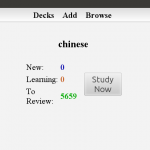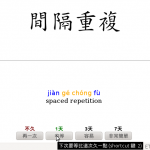Articles tagged with ‘Anki’ Page 2
-
Sensible Chinese character learning revisited
In a way, learning Chinese characters is very much like learning vocabulary in any foreign language and much of the efficient methods developed there works well for Chinese as well. However, characters are also fundamentally different from words in English and this influences how we should learn them as well. This article is a recap of how to learn Chinese characters in a sensible way. It is also a prologue for the upcoming character learning challenge.
Read → -
Flashcard overflow: About card models and review directions
The question of how to design flashcards is faced by all learners who use them. What should you put on the front? What should you put on the back? Should you add single characters or whole words? Or perhaps sentences are better? The general answer is that it depends and this article discusses some of the factors the answers depend on.
Read → -
Why manually adding and editing flashcards is good for you
Creating your own flashcard is not a waste of time, even if you can find the deck you want on the internet. I have created a fair number of public decks and wouldn’t have downloaded those decks even if they would have been available at the time. Creating your own flashcards gives you control over your deck and facilitates learning in many other ways.
Read → -
If you think spaced repetition software is a panacea you are wrong
Spaced repetition software (SRS) is widely discussed online, and generally speaking, there is a spectrum between people who think SRS is the holy grail of learning anything and those that think SRS is artificial, passive and just a waste of time. This article argues that this polarisation is a serious mistake, SRS is a tool and like any other tool, how we use it determines what we get from it.
Read → -
Learning how to learn Chinese through self-experimentation
Rigorous scientific research typically requires large sample sizes, otherwise it isn’t possible to draw any conclusions about the population at large, which is the goal of most studies. However, experimenting with yourself as the only participant might not be relevant for other learners, but it’s highly relevant for you. This article is about how to use self-experimentation to learn Chinese.
Read → -
Is your flashcard deck too big for your own good?
If you use spaced repetition software like Anki for learning Chinese and do so for a few years, you will end up with a very large flashcard deck. Some people advocate deleting the deck if it becomes too big. This article looks closer at the pros and cons of keeping large decks and why you might want to consider starting over from scratch.
Read → -
Sensible character learning: Progress, reminders and reflections
The sensible character challenge has now been running for two weeks and it’s time to see how things have been going so far. This post is a progress report that contains some reflections on the challenge itself, as well as some practical advice on how to solve common problems. It also invites participants to share their experience and progress so far.
Read → -
Towards a more sensible way of learning to write Chinese
This character learning challenge strives to teach students to learn Chinese characters in a way that makes sense in the long term. While the challenge is over, the principles are still applicable!
Read → -
Measuring your language learning is a double-edged sword
Spaced repetition software offers a great way of measuring progress, every step forward is recorded and clearly visible. However, this is also a trap, because even though SRS is useful, it’s just a tool, not a comprehensive strategy. Measurable progress is a great help, but only if you use it correctly.
Read → -
Answer buttons and how to use SRS to study Chinese
Spaced repetition is very powerful compared to massed repetition, which is why software utilising the spacing effect is growing ever more popular. In this article, I discuss how to review vocabulary using SRS, including how to use the various answer buttons and some other functions commonly available.
Read →






